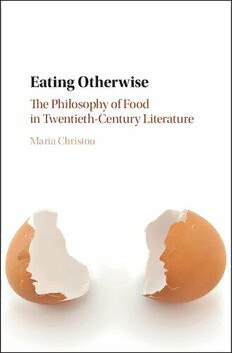
Eating Otherwise: The Philosophy of Food in Twentieth-Century Literature PDF
Preview Eating Otherwise: The Philosophy of Food in Twentieth-Century Literature
This book explores the philosophical implications of the popular adage C h that “you are what you eat” through twentieth-century literature. It r i s investigates the connections between the alimentary and the ontological: to u between what or how one eats and what one is. Maria Christou’s focus is on two influential modernist figures, Georges Bataille and Samuel Beckett; E and two influential postmodernist figures, Paul Auster and Margaret a t Atwood. She aims to theorize the relationship between modernism and i Eating Otherwise n postmodernism from a specifically alimentary perspective. By examining g O the work of these major twentieth-century authors, this book focuses on t The Philosophy of Food strange or unusual acts of eating – eating otherwise – as a means to ways h e of being otherwise. What can eating tell us about being, about who we are r in Twentieth-Century Literature C w h and about our being in the world? This powerful, innovative study takes ris is t literary food studies in a new direction. o e u . 9 Maria Christou 7 81 Maria Christou is an Associate Lecturer at the Department of English and 1 0 8 Creative Writing at the University of Lancaster. She has published articles 4 1 6 in Angelaki: Journal of the Theoretical Humanities and Literature and 8 2 5. J Theology, and has a forthcoming chapter in The Routledge Companion to a c Literature and Food. Eating Otherwise: The Philosophy of Food in Twentieth- k e t. C Century Literature is her first book. M Y K Printed in the United Kingdom/States of America Jacket image: Agnieszka Grandowicz/Getty Images EATING OTHERWISE This book explores the philosophical implications of the popular adage that “you are what you eat” through twentieth-century litera- ture. It investigates the connections between the alimentary and the ontological:betweenwhatorhowoneeatsandwhatoneis.Concen- trating on strange or unusual acts of eating, Maria Christou reads eating otherwise as a means to being otherwise. She focuses on two influential modernist figures, Georges Bataille and Samuel Beckett; andtwoinfluentialpostmodernistfigures,PaulAusterandMargaret Atwood. By examining the work of these major twentieth-century authors,shetheorizestherelationshipbetweenmodernismandpost- modernismfromaspecificallyalimentaryperspective.Thispowerful, innovativestudy takes literary food studies ina new direction. maria christou is an associate lecturer at the Department of English and Creative Writing at the University of Lancaster, where she completed a PhD funded by the Arts and Humanities Research Council.ShehaspublishedarticlesinAngelaki:JournaloftheTheor- etical Humanities and Literature and Theology, and she has a forth- coming chapter on genetically modified food in The Routledge Companion to Literature and Food. Eating Otherwise: The Philosophy ofFood in Twentieth-Century Literature isher first book. EATING OTHERWISE The Philosophy of Food in Twentieth-Century Literature MARIA CHRISTOU LancasterUniversity UniversityPrintingHouse,Cambridgecb28bs,UnitedKingdom OneLibertyPlaza,20thFloor,NewYork,ny10006,USA 477WilliamstownRoad,PortMelbourne,vic3207,Australia 4843/24,2ndFloor,AnsariRoad,Daryaganj,Delhi–110002,India 79AnsonRoad,#06–04/06,Singapore079906 CambridgeUniversityPressispartoftheUniversityofCambridge. ItfurtherstheUniversity’smissionbydisseminatingknowledgeinthepursuitof education,learning,andresearchatthehighestinternationallevelsofexcellence. www.cambridge.org Informationonthistitle:www.cambridge.org/9781108416825 doi:10.1017/9781108242004 ©MariaChristou2017 Thispublicationisincopyright.Subjecttostatutoryexception andtotheprovisionsofrelevantcollectivelicensingagreements, noreproductionofanypartmaytakeplacewithoutthewritten permissionofCambridgeUniversityPress. Firstpublished2017 PrintedintheUnitedKingdombyClays,StIvesplc AcatalogrecordforthispublicationisavailablefromtheBritishLibrary. LibraryofCongressCataloging-in-PublicationData names:Christou,Maria,1988–author. title:Eatingotherwise:thephilosophyoffoodintwentieth-centuryliterature/MariaChristou. description:1[edition].|NewYork:CambridgeUniversityPress,2017.| Includesbibliographicalreferencesandindex. identifiers:lccn2017016929|isbn9781108416825(hardback:alk.paper)| isbn9781108404204(pbk.:alk.paper) subjects:lcsh:Food–Philosophy.|Foodinliterature. classification:lccb105.f66c472017|ddc809/.933564–dc23 LCrecordavailableathttps://lccn.loc.gov/2017016929 isbn978-1-108-41682-5Hardback CambridgeUniversityPresshasnoresponsibilityforthepersistenceoraccuracy ofURLsforexternalorthird-partyinternetwebsitesreferredtointhispublication anddoesnotguaranteethatanycontentonsuchwebsitesis,orwillremain, accurateorappropriate. Contents List of Illustrations page vi Acknowledgments vii Introduction: You Are What You Eat: Thinking Food Otherwise 1 1 Georges Bataille’s Pornographic Food 29 2 Samuel Beckett’s Alimentary Cogito 57 3 Food, the Fall, and the Detective: The Case of Paul Auster 91 4 Food in Margaret Atwood’s Dystopias 120 Conclusion: Modernism, Postmodernism, and the Otherwise of Eating 147 Notes 160 Bibliography 186 Index 204 v Illustrations 1 Johannes Janssonius, frontispiece of William Harvey’s Exercitationes de generatione animalium (1651). Detail. The full image depicts Zeus holding the egg from which the living beings emerge. Wellcome Images (L0006635): http://wellcomeimages.org/ Creative Commons Attribution license CC BY 4.0: http://creative commons.org/licenses/by/4.0/ page 27 2 Edia Connole and Scott Wilson, En soirée culinaire par Georges Bataille, pour Radical Love II (undated). Layout/Design: Danielle O’Connell. Mouth: https://mmmouth.wordpress.com/en-soiree- culinaire-par-george-bataille/ 31 3 A Latin schematic drawing of the Tree of Life – showing the most common arrangement of the ten sefirot – based on a 1625 version by Philippe d’Aquin. Wikipedia Images: https://upload.wikimedia.org/ wikipedia/commons/thumb/2/20/Kircher_Tree_of_Life.png/519px- Kircher_Tree_of_Life.png Creative Commons Attribution license CC BY 4.0: http://creativecommons.org/licenses/by/4.0/ 101 vi Acknowledgments I am very grateful to all those who have made this book possible. Firstly, I want to thank Joel Evans, who has read each chapter more times than I can remember, always offering his encouragement, suggestions, and criticism; I really can’t thank you enough, Joel. The same goes for John Schad – thank you, John, for your continued support. Thanks are also due to Steven Connor and Arthur Bradley, who have provided me withtheirfascinatingobservationsandcriticismsonthemanuscript.Iowe a debt of gratitude to Ray Ryan and to my two anonymous Readers too, for believing in the book and for their much-valued suggestions. Finally, I would like to acknowledge that I would not have been able to write this book without the funding I received from the Arts and Humanities Research Council. vii
